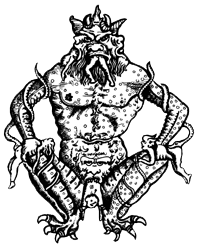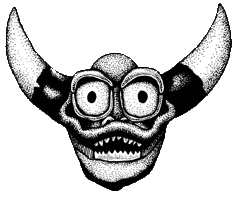
Fabian Küchler
Learning from the Chaos Feature Competition
The Chaos Feature Competition struck me as yet another great Glorantha Fandom project. Alas, I did not find the time to contribute myself, but after some serious nagging from Matthew, nothing could keep me from eagerly scanning the results and vote for the best ideas! It was hard to make a choice so I was skimming through the results again and again to find my favourites. I soon realised I needed some criteria to judge the ideas and narrow my list down. I became more and more fascinated. What lay before me were not only some great, witty, clever or funny Chaos Features, but the creative output of a large part of the Glorantha tribe! Looking at all the ideas I knew that there was something to be learned. I began to wonder: Are the contributors all GM’s or even writers? What game system are they using? How does their creative process work? How do they judge their ideas? I was sure analyzing the results would turn out to be a fruitful creative lesson. What criteria does a good Chaos Feature need to fulfil? How do you design a true Chaos Feature?

Be Chaotic!
A lot of the entries made me wonder: is this really Chaos? Some features were clever, sophisticated and much too intelligent for my taste. Does Chaos really produce these complicated, smart and almost delicate features? Chaos mutates, twists, deforms and produces dangerous abnormities that mock the reality of Glorantha. Ask yourself if your feature is truly chaotic or rather something that looks like the result of very complicated science experiment gone wrong.
Creepy is good. Dangerous is better.
Another observation was that some features, while being really chaotic in nature, were just creepy. Creepy is cool for a chaos feature but it also should pose a danger at the same time otherwise it is mere colour. If you can do creepy you should be able to do creepy and dangerous.
Only Funny on Paper?
Some entries were fascinating to read, but I soon realized they are only funny on paper. They were creations too special for a simple encounter but also lacking the necessary clips to attach their chunky bodies easily to a story. It would be hard to integrate them into a plot without disturbing an existing narrative. Remind yourself that you create for an interactive story not a literary one. The feature needs to be put into action without many words and it needs to do something that players can experience and interact with. An additional rule of thumb: if your name for the feature does not already tell an awful lot about what it does and you need a lot of description it might be just too complex.
Don’t make the Storm Bulls Laugh!
Some Chaos Features where just pretty darn useless (from a Chaos point of view). And I am not talking about the ones who clearly follow the good old tradition of Glorantha jokes. While I am sure that Chaos also produces a lot of substandard material that does not mean it should turn up in a game without a good dramatic reason. Some features were just so colossally ineffective that you pity the chaos creature or even wonder how it could survive with it at all.Imagine yourself being Storm Bull and look at your feature. What do you think? If you feel like laughing you might have to redesign. Making the Storm Bulls laugh to death might be an interesting option though…
Design for the Story not the Game System
Of course some entries were very rules orientated. While not a bad thing per se, this approach tends to produces result that are, well – 'rulesy'. They have the advantage to be used and resolved instantly in game play but seem to force imagination into a more technical or mechanical direction. Designing for the story instead for the rules looks preferable. A Chaos Feature should add drama beyond the cold horror of rules lawyers. It should affect your game story. On the other hand a chaos feature should surely be useable and interact-able within your game system.
Show, not Tell
When you have a Chaos Feature you should be able to show it. It should be as vivid an image as possible. What is the use of a Chaos Feature if you need forever to describe or explain it? Or the players have a hard time to even recognize it or find out only later after they killed it? Chaos should and make a lasting, memorable impact and not cause a dizzy head or confused looks. To be able to show a Chaos Feature means to be able to tell a story with it. Ideally you should be able to create a lasting scene with it and make it the main obstacle for the players to overcome.
Is it New?
Why make the effort to think up stuff (especially for a contest!) if not for producing something innovative by pushing our imagination further? The result should be new, inspiring and, if possible, change the way we see or use a Chaos Feature in a game.
In conclusion
I realized that a Chaos Feature could be more then just a shocking deformation of a creature that players disturb in its lair or that disturbs your players on their Tula. A great Chaos Feature can not only personalize a great antagonist but also drive a scene or even a whole story.My personal Chaos Feature Competition winner is: Merges with Mount by Jamie MacLaren.
Merges with Mount
Any creature that the chaotic can sit on or ride becomes an extension of the chaotic, if the 'mount' is intelligent then there is a continual power struggle for dominance between the two parties requiring concentration and strength of will.Not only does this feature not really require a description it is utterly chaotic, horrible, fascinating and inspiring. It comes with a vivid picture and is frankly almost the only Chaos Feature I could remember from the whole bunch weeks afterwards. Its effect is not danger or damage - it is sheer terror. I can’t imagine a player who would not filled with terror imagining his character could become the mount of a chaos creature! This feature has story value! It makes me want to use it in a game. Jamie, I salute you!






